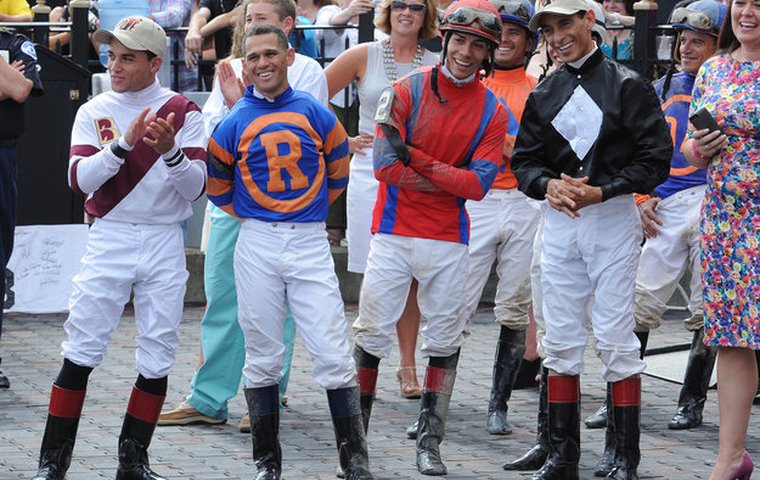
This week, our editorial content will focus on riders around the world. From profile stories to pieces addressing some of the issues riders face in the morning, the afternoon, and at the conclusion of their careers, we will take a closer look at the human athletes so central to our sport.
While the eyes of the U.S. racing world will be focused on Gulfstream Park on Saturday night when this year’s Eclipse Award winners will be announced, next Monday a less-heralded but equally important event will take place in South Florida when jockey John Velazquez offers the opening remarks for the 2015 Jockeys’ Guild Assembly.
Not a union, the Guild advocates for measures to improve the health and safety of jockeys. Held annually, the Assembly brings together Guild representatives from across the country, riders, and representatives from industries whose work and products can enhance jockeys’ welfare on and off the track.
The dates of the Assembly, which runs from Jan. 19-20, are strategic, said Terry Meyocks, the Guild’s national manager since 2007.
“A lot of our riders are in South Florida for the winter, but we also want to capitalize on the Eclipse Awards” to bring attention to the Guild, he said.
This year’s Assembly marks the Guild’s 75th anniversary, a milestone at which Meyocks sees an opportunity to reflect on the organization’s successes while setting goals for its future.
The theme, he said, is that the Thoroughbred racing industry has to work together for the safety of jockeys and exercise riders.
“Over the years, the existence of the Guild has helped racing create a safer environment by working with tracks and horsemen,” he said. “We know injuries will happen, but we need to do everything we can to reduce injuries for both jockeys and exercise riders.”
While proud of what the Guild has accomplished, Meyocks is relentless in his insistence that the racing industry needs to keep improving, pointing to the 2014 deaths of promising young jockey Juan Saez in a racing accident at Indiana Grand racetrack and of exercise rider Juan Vasquez at Belmont Park.
Among the topics at this year’s Assembly is an issue facing not just jockeys, but athletes in a range of sports: concussions.
If major sports like football and hockey were slow to acknowledge the extent of the dangers associated with player concussions, horse racing in the U.S. has been positively glacial, with few standard concussion protocols and none nationwide. Practices in the U.S. are in stark contrast to those in the U.K., which for more than a decade has required baseline concussion testing for jockeys.
Such testing is in its infancy here, and in place at only a few racetracks.
The man who developed the testing protocols here is Dr. Mark Lovell, chairman of the board and chief scientific officer of ImPACT Applications and founding director of the University of Pittsburgh’s Medical Center’s Sports Medicine Concussion Program. Lovell has also developed and directed neuropsychological testing programs for the National Football League and the National Hockey League. Lovell will be a featured speaker at the Assembly, his topic “Setting the Pace in the Management of Concussion.”
“Our industry is so far behind,” lamented Meyocks. "We’re probably 15 to 20 years behind Europe.”
Assembly participants will also hear from Brian Shaffer of Chesapeake Testing, a Maryland-based organization that tests safety equipment, including helmets, for athletes in a variety of sports.
One of the challenges facing the Guild is the funding to implement safety initiatives at racetracks. Meyocks has long advocated for greater promotion of jockeys as a way to market horse racing and develop fans, and JockeyTalk360.com aims to do just that, along with raising awareness of the financial needs of injured jockeys through the Permanently Disabled Jockeys Fund. Corey Johnson, president of both JockeyTalk360.com and Kentucky Downs racetrack, will address the assembly on the topic of promoting jockeys through social media.
Other speakers will include Ken Munao of Morgan Stanley Wealth Management to offer advice to jockeys on retirement planning and J. Curtis Linnell of the Thoroughbred Racing and Protective Bureau on betting exchanges and integrity.
Regional Guild managers will also offer updates, as will Mike Ziegler of the NTRA’s Safety and Integrity Alliance.
Though not on this year’s agenda, the topic of the Guild’s Jockey Injury Database is one that Meyocks hopes will be discussed informally.
“We’re having problems with the industry supporting it,” he said of the program established in 2012 to track injuries to riders. The database was created to collect information on injuries that jockeys sustain at the racetrack, including where, when, and how injuries occur; the types of equipment the jockey was wearing at the time of the injury, and the nature and severity of the injuries.
The information is then sent -- with jockeys’ names removed -- to the University of Kentucky for analysis, but Meyocks is frustrated by the slow adoption of the program by racetracks, which he thinks offer long-term benefits to the tracks themselves.
“Everyone’s worried about the cost of insurance and workers’ compensation, and this information can help us see when and where accidents happen, and what caused them,” he pointed out. “We’re trying to reduce risks to benefit the racetracks.”
Also on Meyocks’ list of concerns is better testing of riders’ safety equipment, including vests and helmets; the use of shockwave therapy on horses, which if administered improperly could mask pain due to an injury that could imperil both the horse and the rider in a race; and the lack of paramedics on-course at many tracks in the U.S.
While not all of those topics will be addressed at next week’s Assembly, the gathering will give Meyocks and other Guild members the opportunity to talk with industry representatives and members of the media about these and other issues facing riders.
“The risk is shared by all stakeholders,” maintained Meyocks. “And the industry benefits from a strong voice for jockeys.”

